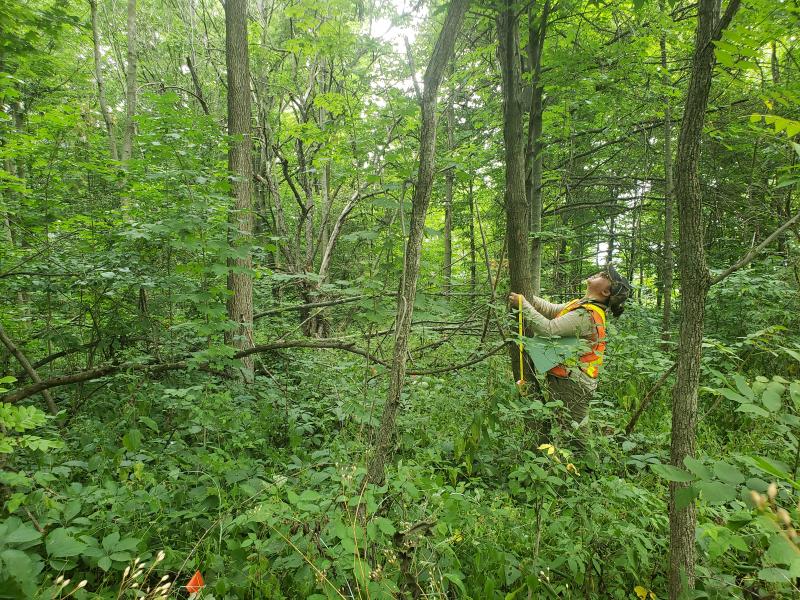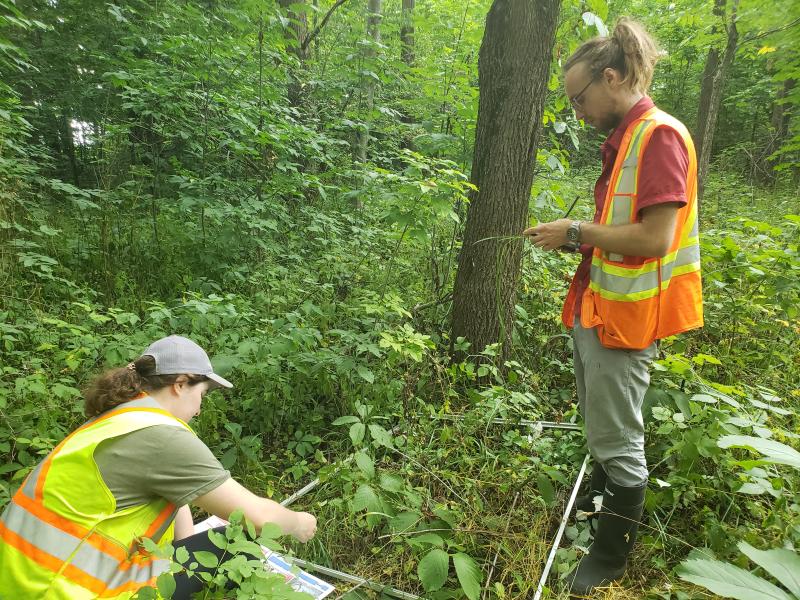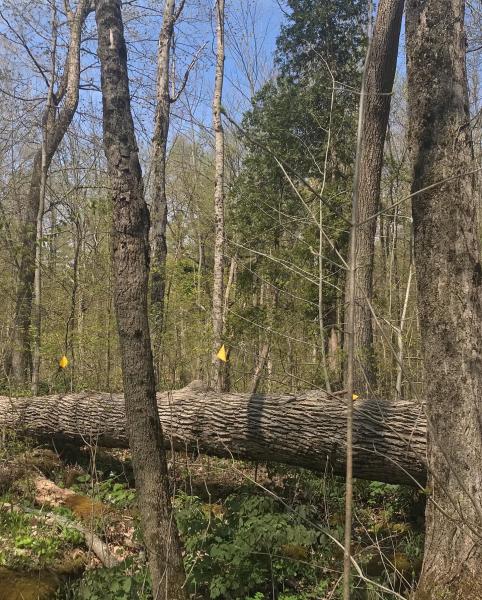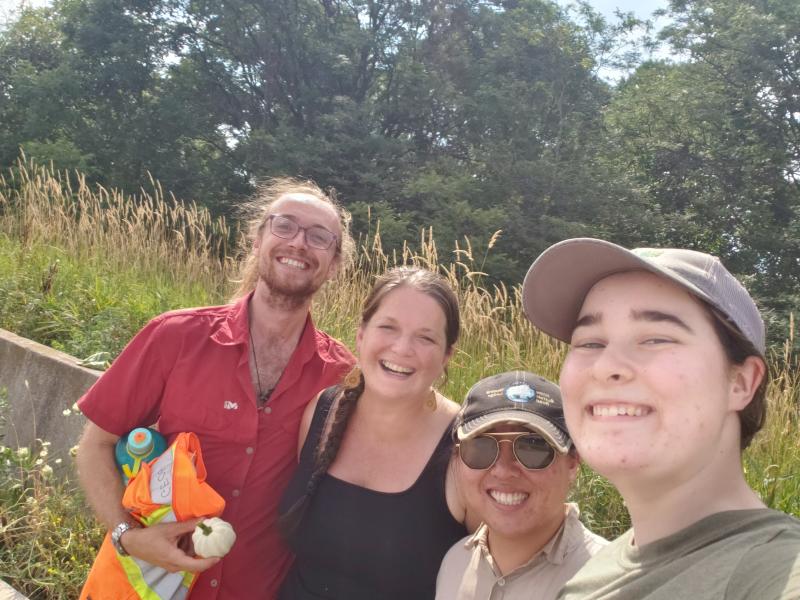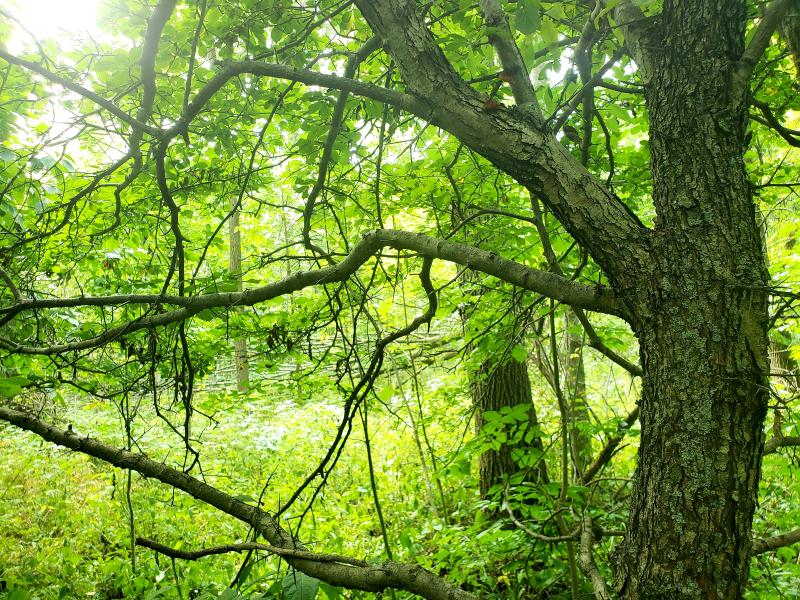
Tewathnekohétstha’ “The Water Passes Through”
Miskwaanzo Ishpadinaa Dannaa
Location
GPS Coordinates
The Red Hill Valley, carved into the Niagara Escarpment by Red Hill Creek, is a significant geologic formation in Hamilton. Spanning 12 km, the valley begins at Albion Falls, where Red Hill Creek plummets down the escarpment face, and flows north where it empties into Lake Ontario at Confederation Park. You can hike through the valley via the Red Hill Trail and its various side trails, and, despite the impact of the Red Hill Parkway, the valley remains one of Hamilton’s largest urban greenspaces.
The Red Hill Valley is located in the Carolinian forest zone and is composed of lush deciduous forests dominated by walnuts, as well as cultural forests that reflect the legacies of Indigenous plant relationships throughout millennia, such as the continual presence of edible and medicinal native species, as well as previous European agricultural and silvicultural land use, such as orchards and a small section of white pine plantation. Legacy forests are present at the southern to central end of the valley, indicated by the presence of numerous species of hawthorn trees with a thick raspberry underbrush, red and white pine trees growing in neat rows, and a patch of black ash swamp and cedar swamp at the lower end of the creek. Naturalization has begun to occur in the European agricultural/silvicultural land use areas, with the return of sugar maple, dogwoods, ashes, black walnut, and red oak to these sites.
Drier, upper slope positions above the Red Hill Creek are home to open woodland, which have a loose cover of shrubs, small walnut, ash and hawthorn trees, and an abundance of asters, goldenrods, fleabanes. The trees thicken as we descend into the Red Hill Creek floodplain, and oaks and sugar maple are replaced by moisture loving species such as bitternut hickory, willows, and Manitoba maple. The understories of these floodplain forests are dominated by large and dense patches of the gregarious garlic mustard, but is nevertheless home to spring ephemerals plants such as trillium, bloodroot, wild ginger, jack-in-the-pulpit, ramps, hepaticas, avens, anemones, as well as sedges, goldenrods, and other woodland herbs.
Archaeological excavations have documented Indigenous presence in Red Hill Valley over several time periods from ~11 000 years ago to present. The oldest record of human settlement comes from the Mt. Albion site, which was excavated in 1998. The Mt. Albion site is an Indigenous settlement that has been classed by archaeologists as “Paleoindian from the Gainey culture group.” The Gainey culture group describes Indigenous communities who lived in southern Ontario from ~10,500 to 11,000 year ago; Gainey as a descriptor refers both to a time-period and Indigenous peoples whose archaeological records display similar cultural characteristics, and who lived across the Great Lakes region and the eastern seaboard of the United States – those peoples sometimes now referred to as the Maple Nations and Dawnland Peoples. Archaeologists characterize Gainey sites by their unique tool assemblages, including long projectile points that were deeply concave at its base with fluted faces and parallel sides, and triangular scrapers. Archaeologists found stone tools at Mt. Albion on which they detected mammoth blood, which may indicate that these ancient peoples hunted mammoths. Furthermore, the finding of varied tool materials suggests that Indigenous peoples of modern-day Southern Ontario hunted in the Red Hill Valley, and covered a wide geographical base in support of their lifeways, ranging from Georgian Bay and to the northeast end of Lake Erie.
Human occupation of the valley during the archaic period of 3000-4500 BCE is documented at what archaeologists call the Spera sites. These sites appear to have been two seasonal campsites which we know from Indigenous oral histories and cultural interpretation are permanent places of dwelling that people occupied seasonally, rotating sites depending upon food sources and for other reasons.
Indigenous people began to build year-round permanent dwellings in the Red Hill Valley during the period that archaeologists refer to as the Woodland Period, a period of time that stretches from 1000 BCE until when Europeans began to colonize North America in 1492. The most extensively researched Woodland site is the King’s Forest Site, located at modern Rosedale Park. The King’s Forest Site represents an Iroquoian village dating to ~1200 CE. This is reflected by the excavation of two intact longhouses, a lodge that may have been used ceremonially, several refuse pits and middens, and the remnants of several other large structures. Furthermore, several tens of thousands of stone, ceramic, copper, turtle carapace, and bone artifacts have been unearthed at this site, which include tools, vessels, effigies, beads, awls, net sinkers, artistic pieces, fish spine needles (for making nets and sewing), and painted turtle shells. This site may have been occupied for shorter periods during the middle and late archaic and early woodland periods, evidenced by the finding of small amounts of projectile points that carbon dated to 2000-2500 BCE, 900-1300 BCE, and 800-1200 BCE.
During the height of the village at the King’s Forest site during the 13th century, when it appears to have been at its most populous, the Iroquoian peoples there practiced a combination of agriculture, gathering, hunting, and fishing foodways and lifeways. Cultivated crops included maize, tobacco, sunflower, beans and gourds (squashes), while harvested plants included strawberry, bramble (raspberries and blackberries), hawthorns, chenopods (greens and grains from the goosefoot family), knotweed, sumac, cattail, spikenard, butternut, hickories, and acorns. Furthermore, a wide variety of animal, bird, fish and mollusk species were consumed, including turtles, walleye, bass, pike, trout, catfish, passenger pigeons, waterfowl, grouse, turkey, gray squirrels, raccoons, and deer. The village at King’s Forest was built next to the Red Hill Valley Creek, where there was a sandy plain suitable for agriculture, abundant water for irrigation, and easy access to wetlands and waterways for fishing. Written settler descriptions upon their arrival of the Iroquois plain landscape on which the Kings Forest site was built, show that it was a managed hardwood forest with little understory, full of oaks, hickories, maple, beech, ashes, elm, ironwood, and white pine.
European and American settlers began to move into the valley during the late 1700s, after the American Revolution/ American War of Independence. They founded Hamilton as a settlement in the early 1800s and it grew quickly. In 1929, the City of Hamilton purchased and incorporated the Red Hill Valley for parkland. Nineteen fifty-seven was the first year that city officials proposed construction of the Red Hill Parkway, and over the next 50 years, regional residents debated whether it should be built. Several scholarly works have documented the years around when the project was finally approved to its construction, including resistance to the project by many members of Six Nations of the Grand River, New Credit Mississauga First Nation, and the urban Indigenous community of Hamilton. In 2002, City Councilors and the Haudenosaunee Confederacy Chiefs Council came to an agreement to form a Joint Stewardship Board, to co-manage the restoration and stewardship of the valley during and after the construction of the Parkway through it. The Joint Stewardship Board created a pathway for applied environmental stewardship following the practices and protocols of the Two-Row Wampum, the Dish with One Spoon, and other Haudenosaunee Environmental Philosophies, co-governance and decision-making practices. As a result, Six Nations of the Grand River and New Credit members have worked with city and conservation authority employees to conduct a variety of activities in and around the valley, including environmental monitoring, ecological restoration, and community outreach, guided by a combination of scientific and Haudenosaunee ecological knowledge. The Joint Stewardship process that they created, based upon a Two-Row Wampum model, provides an example that can be improvised upon for future co-management projects and practices in the region.
The Stage 4 Salvage Excavation of the King’s Forest Park Site (AhGw-1) Cultural Heritage Resource Assessment, Red Hill Creek Expressway (North-South Section) Impact Assessment, City of Hamilton, Ontario. 2007. By Archaeological Services, Inc.
chrome-extension://efaidnbmnnnibpcajpcglclefindmkaj/https://asiheritage.ca/wp-content/uploads/2020/06/Kings-Forest-Park-Sit…
Biological Inventory of the Red Hill Valley. 1995. Prepared by Hamilton Naturalists’ Club for Hamilton Conservation Authority, Ancaster, Ontario.
Dolan, Jessica M. Forthcoming article (2024). “Red Hill Valley Revisited: Implementing Haudenosaunee Environmental Knowledge and Joint Stewardship as a pathway for Environmental Decision-making and Nation-to-Nation Governance in Ontario.”
Johnson, Lorraine. 2007. The Natural Treasures of Carolinian Canada: Discovering the Rich Natural Diversity of Ontario’s Southwestern Heartland. Carolinian Canada Coalition.
The Joint Stewardship Board is a partnership between the Haudenosaunee and the City of Hamilton to jointly steward the Red Hill Valley using a biocultural, Two-Row Wampum, nation to nation orientation: http://jointstewardshipboard.com
Kelly, Peter E. and Larson, Doug. 2007. The Last Stand: A Journey Through the Ancient Cliff-face Forest of the Niagara Escarpment. Natural Heritage Books.
Red Hill Valley Virtual Field-trip, by Carolyn Eyles and Susan Vajoczki; Prepared by Zachary Windus, Liz Kenny; School of Geography, McMasger University, 2004. Red_Hill_Valley.PDF (mcmaster.ca)
Peace, Walter G.. 1998. From Mountain to Lake: The Red Hill Creek Valley. Olmstead Books, Port Dover, Ontario.
| English | Latin | Kanienʼkéha | Anishinaabemowin |
|---|---|---|---|
| Wild Ginger | Asarum canadense | tsyonehskwénrye | namepin, nmepin |
| Bitternut Hickory | Carya cordiformis | o’nón:na, ontsí:kahwe, yohso'kwatskà:rat | mitigwaabaak (-ook, plural) |
| Green Ash | Fraxinus pennsylvanica | kaneróhon | emikwaansaak, aagimaak, bwoyaak |
| Mock Strawberry | Potentilla indica Andrews (Th. Wolf) | ken’niiohontesha, niyohentéhsha’ | odeimin |
| Staghorn Sumac | Rhus typhina | tará:kwi | paakwan, baakwaanaatik, baakwaanmizh, ma'kibag, kaagaag-miin-gaawahnshiik |
| Green Ash | Fraxinus pennsylvanica | kaneróhon | emikwaansaak, aagimaak, bwoyaak |
| Manitoba Maple | Acer negundo | kahwisto’kéha wáhta | adjagobi’mak |
| Sugar Maple | Acer saccharum | wáhta’, ohwáhta | ininaatik, ininaatig (-oog, plural) |
| White Snakeroot | Ageratina altissima | teyohontáthe | bi'jikiw'ack |
| Wild Leeks | Allium tricoccum | o'nyónkseri | bgoji-zhi, agaagawinzh (-iig, plural), siga'gawanj, siga'gawanch |
| Giant Ragweed | Ambrosia trifida | tsitha aotíkhwa | (check this) |
| Jack-in-the-pulpit | Arisaema triphyllum | tyehnónhserote, kyehnónserote, kárhon, tsyorákares, tsorákares, kahnéhserote, okwá:rot nikarhonksherá:'a | zhaashaagomin |
| Wild Ginger | Asarum canadense | tsyonehskwénrye | namepin, nmepin |
| Pepper root | Cardamine diphylla (Michx.) Alph. Wood | à:tsya | waasganjiibik |
| Bitternut Hickory | Carya cordiformis | o’nón:na, ontsí:kahwe, yohso'kwatskà:rat | mitigwaabaak (-ook, plural) |
| Alternate-leaf Dogwood | Cornus alternifolia | teyotsí:tsayen | moozwemizh, moozomizh, niibiishan miskwaabiimizhiig |
| Gray Dogwood | Cornus racemosa | tsítyete | mazh’omizh |
| Red Osier Dogwood | Cornus sericea | onekwén:tara niwatahtsherò:ten, o’seranekwénhtonh, watatshero:'ten, onekwénhtara niwatatsherò:ten | miskwabi 'mik, mskwabiimnagohns, miskwaabiimizh "red shrub" Cornus sericea |
| Late Hawthorn | Crataegus calpodendron | ohì:kta wahyarà:ken; yotironhwentsí:yo | miinensgaawanzh |
| Wild Carrot | Daucus carota | anonhsanónhna, watatewenní:yo otsíhkwa | kaadaakoon |
| Spinulose Wood Fern | Dryopteris carthusiana | yetskarónhkwa, onitskerónhkwa, yetskaronhkwa'kó:wa | naanaaganashk (-oon), mzise miijim |
| Intermediate Wood Fern | Dryopteris intermedia | yetskarónhkwa, onitskerónhkwa, yetskaronhkwa'kó:wa | naanaaganashk (-oon), mzise miijim |
| Aster annus | Erigeron annuus | yako’tonhkwárhos onónhkwa | name'gosiibag |
| Trout Lily | Erythronium americanum | skatsihstóhkonte | namegbagoniin |
| Woodland Strawberry | Fragaria vesca L. | ken’niiohontesha, niyohentéhsha’, niyohontéhsa, ken’niyohontésha | odeimin (-an, plural) |
| Green Ash | Fraxinus pennsylvanica | kaneróhon | emikwaansaak, aagimaak, bwoyaak |
| Sharp-lobed Hepatica | Hepatica acutiloba | kontirontá:non, karón:tanonhne | gabisan’ikeag, a'nima'sid |
| Spotted Jewelweed | Impatiens capensis | ietsi'erorókhstha, yetsi'erorókhstha | gzhiibosegaateaa, makikiibag, wesa’wasga’skonek, ozaawashkojiibik |
| Butternut | Juglans cinerea | tyohwá:ta, kyewhá:ta, tyehá:ta, atyehwà:ta, tsiohsò:kwehs | mtigwaabaakook |
| Black Walnut | Juglans nigra | tsyohsò:kwak | bagaanaak |
| False Solomon’s Seal | Maianthemum racemosum | kítkit o'éta | agongseminan, agongosimizh, agong’osiminan |
| Wild Bergamot | Monarda fistulosa | yeton'kwanonhsatáhkwa, iako'tonhkwanóstha, Ie'tonhkwanostáhkhwa | sasap-kwanins, sasaapkwaanins, weca'was wackwi'nek, bibi'gwanakak |
| Common Yellow Woodsorrel | Oxalis stricta | teyoratu teyorá:ton | ziiwanabagashk |
| Virginia Creeper | Parthenocissus quinquefolia | kontiráthens | mnidoo- biimaakwad bebaamooded |
| Smartweed | Persicaria virginiana | aweryahsarónyon, tyononhkwà:tsheros | ojig'imin |
| White Pine | Pinus strobus | tyonerahtase'kó:wa, onehta'kó:wa, ohnehta’kó:wah | biisaandago-zhingwaak, zhingwaak, shingwaak |
| Red Pine | Pinus resinosa | onehtóya | baakawangemaakook, bapakwanagemag |
| Common plantain | Plantago major | atenhnéha, teyohahó:ron | onaanigizidaanbag (-oon, plural), ginebigowashk, mashkiigobag, omakakiibag |
| Mock Strawberry | Potentilla indica Andrews (Th. Wolf) | ken’niiohontesha, niyohentéhsha’ | odeimin |
| Chokecherry | Prunus virginiana | tyakonya’tawén:’eks, teyakonya’tawén:’eks | asasaweminagaawanzh, asasaweminan, baakinminaan, asasaweminogaawangh |
| White Oak | Quercus alba | otokénha | mitigomizh (-iik, plural) |
| Red Oak | Quercus rubra | karíhton | miskode-miizhmizh, mitig mewish (-iik plural) |
| Staghorn Sumac | Rhus typhina | tará:kwi | paakwan, baakwaanaatik, baakwaanmizh, ma'kibag, kaagaag-miin-gaawahnshiik |
| Red Raspberry | Rubus idaeus | skanekwen’terá:yen, skanekwen’terá:ne, skanekwenhtará:nenh | miskomin (-ak, plural) |
| Purple Flowering Raspberry | Rubus odoratus | ahtahkwakáyu, ahtahkwaká:yon | miskomin (-ak, plural) |
| Bloodroot | Sanguinaria canadensis | tekanekwas, tekané:kwaks, tekanekwénhshya'ks | miskwi- chiibikoon |
| Tall goldenrod | Solidago altissima | otsí:nekwar niyotsi’tsyò:ten | ajidamoowaanow, waabanoominens/waabanoominensag, giizisso mashkiaki |
| Zig-zag Goldenrod | Solidago flexicaulis | otsí:nekwar niyotsi’tsyò:ten | ajidamoowaanow, waabanoominens/waabanoominensag, giizisso mashkiaki |
| Fringed blue aster | Symphyotrichum ciliolatum | teyonerahtawe'éhston, yotsiron’onhkóhare orón:ya | name'gosiibag |
| Calico Aster | Symphyotrichum lateriflorum | teyonerahtawe'éhston, yotsiron’onhkóhare orón:ya | name'gosiibag |
| Purplestem Aster | Symphyotrichum puniceum | teyonerahtawe'éhston, yotsiron’onhkóhare orón:ya | wiiniziikens |
| Arrowleaf Aster | Symphyotrichum urophyllum | yako’tonhkwárhos onónhkwa | name'gosiibag |
| Basswood | Tilia americana | ohóhsera | wiigobiish, wiigob, wiigobiig (plural) |
| Red Trillium | Trillium erectum | tsyonà:tsya onekwénhtara niyotsi’tsyò:ten, áhsen niioneráhtonte | moonigohn, ininiiwindibiigegan, ini'niwin'digige'gun |
| White Trillium | Trillium grandiflorum | tsyonatsyakén:ra niyotsi’tsyò:ten, tsyoná:tsik, áhsen niioneráhtonte | ininiiwindibiigegan, baashkindjibgwaan, baushkindjibgwaun, ini'niwin'digige'gun |
| Stinging Nettle | Urtica dioica | teyutokorúte, yakohesará:tah, óhrhes | bepadji'ckanakiz'itna- zana'tik |
| Maple-leaf Viburnum | Viburnum acerifolium | karhata’kéha | miinan |
| Downy Yellow Violet | Viola pubescens | tekonnyarotárhoks, tekonteniarotáhrhoks, tewatenyarotárhos | we-waawiyeyaa-bagak, wewaie’bagag |
| Common Blue Violet | Viola sororia | tekonnyarotárhoks, tekonteniarotáhrhoks, tewatenyarotárhos | we-waawiyeyaa-bagak, wewaie’bagag, ozhaawashkwaabigwan "blue or green flower/s) |
| Wild Grape | Vitis riparia | o’nénhare | zhoominan, jo’minaga’wanj |
